Internet Archive Download Page
Neo-Africa is doomed unless Harry Flowerpower can defeat six monsters to reclaim the Mystical Hearts stolen by a wizard! The plot is about as nonsensical as they come, but Banana Nababa, a freeware platformer consisting entirely of six boss fights, still holds up remarkably well nearly a decade after its release.
With no gameplay content beyond the boss fights themselves, saying that the combat system is at the heart of Banana Nababa would be an understatement. Our small and very square protagonist doesn’t have many abilities at his disposal beyond jumping, but the two weapons he has complement each other perfectly. The first of these weapons is an axe, which flies in a high vertical arc without much horizontal movement, making it great for taking out bosses which like to fly or jump around the arena. Harry’s second weapon is a spear which he can throw very far away in a straight, horizontal line. In addition to covering a large horizontal distance, the spear gradually moves downward, making it the weapon of choice for enemies which are far away or below Harry. You can swap between these weapons instantaneously and you’ll need to get used to using both of them in order to complete the game.
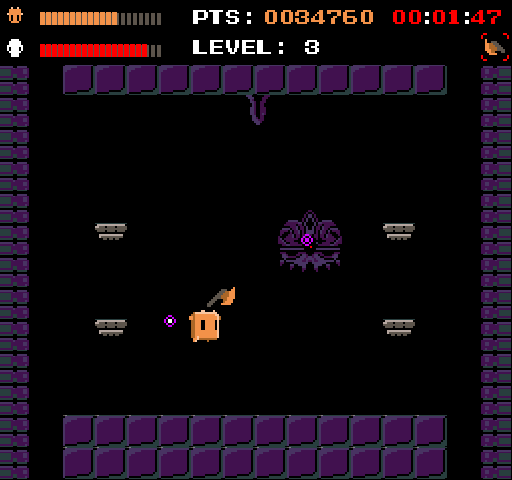
While the spear and axe are both fun weapons to use, there are two downsides to the actual controls in Banana Nababa. First, the controls themselves are somewhat awkward and can’t be adjusted. The spacebar serves as your weapon swapping button, which is fine, but the buttons for jumping and attacking are uncomfortably placed too close to the center of the keyboard with C and F for jumping and V and D for throwing your current weapon. This uncomfortable issue is made worse by the second problem, the fact that you can’t just hold a button down to attack and must instead press the attack button for each and every projectile, which can definitely start to make your hand sore by the end of a fight because bosses tend to have quite a bit of health. Thus, you must choose between awkwardly trying to launch attacks as fast as possible with your middle finger on the D key or putting your entire hand in an uncomfortable position so you can use your index finger for attacking with the V key. It’s certainly not a game breaker, but the uncomfortable and tiring controls here make me very happy that the vast majority of more modern games with similar control schemes choose to make use of Z and X or A and S and often include the option to customize your controls.
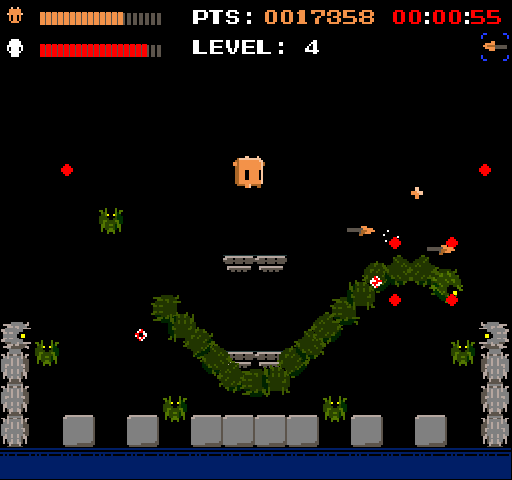
Bosses are the stars of the show here, so let’s start looking at just how they work. Both Harry and the bosses themselves have large health bars similar to those found in the original Castlevania games and, with the exception of the final boss, every boss has two or three forms. Every form in a boss fight has its own health bar and can soak up dozens of hits, though Harry is also fairly durable unless he falls into a pit. In addition to the bosses themselves, many of the fights also contain smaller enemies which periodically pop up to cause trouble, but these minions can be beneficial as they generally go down in a single hit and often drop small yet valuable healing items. Each of the six fights can be completed in roughly two minutes, yet each poses a distinctive and memorable challenge.
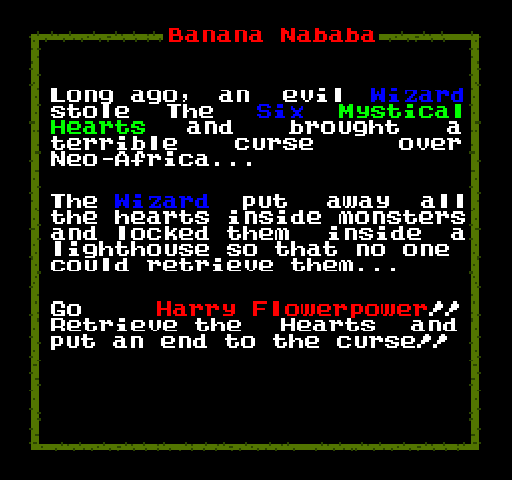
My favorite trait shared by the boss fights in Banana Nababa is the way in which each of them experiments with a specific gimmick as the fight progresses. The first boss, Voodoo Mask, makes for a particularly great introduction to the design philosophy at work here. The initial phase has Voodoo Mask completely stationary in the center of the screen, making it a perfect target for axes while it shoots a few bullets and summons in smaller masks to send waves of fire across the screen. As this game keeps track of your fastest time for each fight, these fire waves create an interesting choice for players because you can either jump to one of the platforms on either side of the arena or you can attempt to jump over the waves, which is much harder to do without taking damage, but it saves plenty of time and allows you to continuously attack the boss. The second phase of the fight starts with the true face of Voodoo Mask being revealed and adds to the patterns established in the first phase with the addition of a new enemy which flies back and forth across the upper part of the screen while periodically dropping fire and Voodoo Mask itself replaces its bullet attacks with eye lasers aimed directly at Harry. While the second phase expands upon an idea, the third and final phase experiments with it. In this phase the additional masks are completely gone and Voodoo Mask has been reduced to a giant hopping skull which shoots out flame waves in both directions when it lands. With this phase you are still faced with the flame waves which have been the main threat throughout the fight, but now many things are considerably different as the boss has become mobile and is generally easier to hit with the spear and the side platformers are no longer an entirely safe option because the boss can follow you to them. Voodoo Mask is neither the best nor the most complicated fight in the game, but it does a wonderful job of introducing players to general way in which fights can progress and shift.
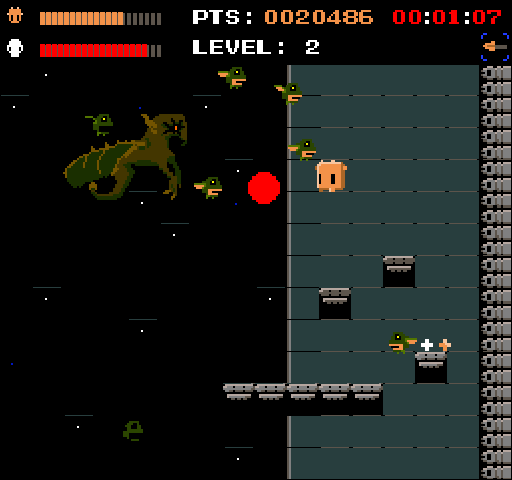
While I wouldn’t call any of the boss fights here bad, they definitely vary in quality. The best boss in the game is almost certainly Plague Beetle, a boss which changes up its movement and attack patterns considerably between its three phases and forces you to constantly swap between the axe and the spear and you fend off flying minions, dodge attack-disabling bullets, and clear away slowing slime; it’s an intense fight from start to finish where you need to constantly decide which hazard to prioritize focusing on while also getting hits in on the boss itself. Giga Slith is another great fight which stands out due to its focus on accuracy; Giga Slith is a snake-like creature which weaves its way between platforms and through the air in various patterns and hitting any part of its body other than its head results in it launching bullets to counterattack. On the lower end of the spectrum you have Swarm Lord and the final boss, both of which suffer from being fairly tedious. Swarm Lord spends the two phases of its fight flying in a circle in a part of the arena which is hard to reach and, as its name suggests, its primary method of attack is to send out fly-like minions to attack you. It’s probably the easiest fight in the game due to all the health drops from the minions, but the limited parts of the arena from which you can actually hit the boss in addition to the fact that the minions often get in the way of your attacks makes it drag on longer than it should. As to the final boss, it’s an appropriately difficult fight, but the boss only has a single phase and about as much health, if not more, as any of the other bosses. The result is an initially engaging fight which gradually wears thin in a game where every other fight builds upon and experiments with the boss’s attack pattern between multiple phases.
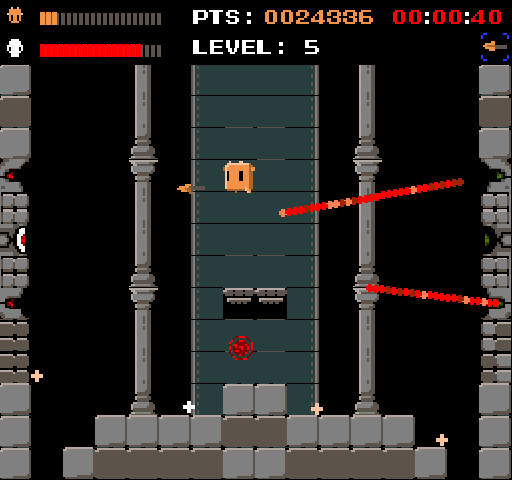
There are definitely some rough edges here, but the core gameplay and many of the fights are exceptionally good and easily counterbalance the somewhat uncomfortable control scheme and the more mediocre fights. The parts in which Banana Nababa shines the brightest make it all the more sad that Super Banana Nababa, the planned sequel/remake, never saw the light of day beyond a few preview videos. Though it may not quite live up to what its sequel could have been, Banana Nababa stands the test of time and remains as entertaining as ever, making it a great short game to go back to every once in a while.